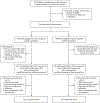Intranasal Oxytocin in Children and Adolescents with Autism Spectrum Disorder
- PMID: 34644471
- PMCID: PMC9701092
- DOI: 10.1056/NEJMoa2103583
Intranasal Oxytocin in Children and Adolescents with Autism Spectrum Disorder
Abstract
Background: Experimental studies and small clinical trials have suggested that treatment with intranasal oxytocin may reduce social impairment in persons with autism spectrum disorder. Oxytocin has been administered in clinical practice to many children with autism spectrum disorder.
Methods: We conducted a 24-week, placebo-controlled phase 2 trial of intranasal oxytocin therapy in children and adolescents 3 to 17 years of age with autism spectrum disorder. Participants were randomly assigned in a 1:1 ratio, with stratification according to age and verbal fluency, to receive oxytocin or placebo, administered intranasally, with a total target dose of 48 international units daily. The primary outcome was the least-squares mean change from baseline on the Aberrant Behavior Checklist modified Social Withdrawal subscale (ABC-mSW), which includes 13 items (scores range from 0 to 39, with higher scores indicating less social interaction). Secondary outcomes included two additional measures of social function and an abbreviated measure of IQ.
Results: Of the 355 children and adolescents who underwent screening, 290 were enrolled. A total of 146 participants were assigned to the oxytocin group and 144 to the placebo group; 139 and 138 participants, respectively, completed both the baseline and at least one postbaseline ABC-mSW assessments and were included in the modified intention-to-treat analyses. The least-squares mean change from baseline in the ABC-mSW score (primary outcome) was -3.7 in the oxytocin group and -3.5 in the placebo group (least-squares mean difference, -0.2; 95% confidence interval, -1.5 to 1.0; P = 0.61). Secondary outcomes generally did not differ between the trial groups. The incidence and severity of adverse events were similar in the two groups.
Conclusions: This placebo-controlled trial of intranasal oxytocin therapy in children and adolescents with autism spectrum disorder showed no significant between-group differences in the least-squares mean change from baseline on measures of social or cognitive functioning over a period of 24 weeks. (Funded by the National Institute of Child Health and Human Development; SOARS-B ClinicalTrials.gov number, NCT01944046.).
Copyright © 2021 Massachusetts Medical Society.
Figures


Comment in
-
Oxytocin for Autism Spectrum Disorder - Down, but Not Out.N Engl J Med. 2021 Oct 14;385(16):1524-1525. doi: 10.1056/NEJMe2110158. N Engl J Med. 2021. PMID: 34644477 No abstract available.
-
Refining oxytocin therapy for autism: context is key.Nat Rev Neurol. 2022 Feb;18(2):67-68. doi: 10.1038/s41582-021-00602-9. Nat Rev Neurol. 2022. PMID: 34880473 Free PMC article.
References
-
- Kosfeld M, Heinrichs M, Zak PJ, Fischbacher U, Fehr E. Oxytocin increases trust in humans. Nature 2005; 435: 673–6. - PubMed
-
- Domes G, Heinrichs M, Michel A, Berger C, Herpertz SC. Oxytocin improves “mind-reading” in humans. Biol Psychiatry 2007; 61: 731–3. - PubMed
-
- De Dreu CKW, Greer LL, Handgraaf MJJ, et al. The neuropeptide oxytocin regulates parochial altruism in intergroup conflict among humans. Science 2010; 328: 1408–11. - PubMed
Publication types
MeSH terms
Substances
Associated data
Grants and funding
LinkOut - more resources
Full Text Sources
Other Literature Sources
Medical
